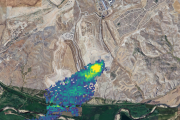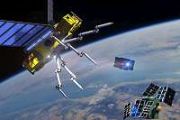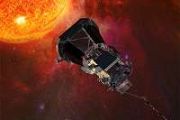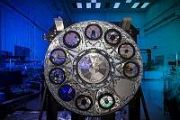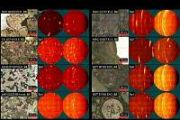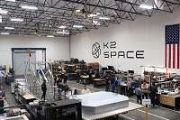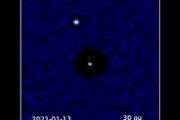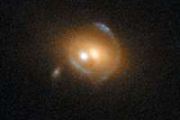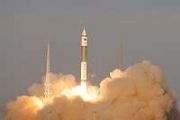
Copernical Team
Unveiling the steady progress toward fusion energy gain
 The march towards fusion energy gain, required for commercial fusion energy, is not always visible. Progress occurs in fits and starts through experiments in national laboratories, universities, and more recently at private companies.
Sam Wurzel, a Technology-to-Market Advisor at the Advanced Research Projects Agency-Energy (ARPA-E), details and highlights this progress over the last 60 ye
The march towards fusion energy gain, required for commercial fusion energy, is not always visible. Progress occurs in fits and starts through experiments in national laboratories, universities, and more recently at private companies.
Sam Wurzel, a Technology-to-Market Advisor at the Advanced Research Projects Agency-Energy (ARPA-E), details and highlights this progress over the last 60 ye NOAA's next-gen weather satellite, built by Lockheed Martin, moves closer to launch
 Today, the next-generation Geostationary Operational Environmental Satellite (GOES)-T successfully arrived at Kennedy Space Center, Florida, to begin launch preparations. It is the third of four satellites in the National Oceanic and Atmospheric Administration (NOAA)'s GOES-R weather satellite series built by Lockheed Martin [NYSE: LMT] in Littleton, Colorado.
GOES-T will help NOAA provide
Today, the next-generation Geostationary Operational Environmental Satellite (GOES)-T successfully arrived at Kennedy Space Center, Florida, to begin launch preparations. It is the third of four satellites in the National Oceanic and Atmospheric Administration (NOAA)'s GOES-R weather satellite series built by Lockheed Martin [NYSE: LMT] in Littleton, Colorado.
GOES-T will help NOAA provide Feeling the heat: Fusion reactors used to test spacecraft heat shields
 Spacecraft have long used heat shields for protection during entry into planetary atmospheres. Future missions to the outer solar system will need more sophisticated materials than currently exist. The extreme heating conditions needed to study new shield materials are, however, very difficult to achieve experimentally on Earth.
Scientists working at the DIII-D National Fusion Facility at
Spacecraft have long used heat shields for protection during entry into planetary atmospheres. Future missions to the outer solar system will need more sophisticated materials than currently exist. The extreme heating conditions needed to study new shield materials are, however, very difficult to achieve experimentally on Earth.
Scientists working at the DIII-D National Fusion Facility at ISS changes orbit to avoid collision with Chinese debris
 The station was hit by space debris earlier this year. A piece of space junk struck the Canadian remote robotic system, but the incident did not affect the operation of the device or the ISS in general.
The International Space Station had to perform a manoeuvre in order to avoid a collision with space junk, left by the Chinese Fengyun-1C satellite, the Russian State Space Corporation Rosco
The station was hit by space debris earlier this year. A piece of space junk struck the Canadian remote robotic system, but the incident did not affect the operation of the device or the ISS in general.
The International Space Station had to perform a manoeuvre in order to avoid a collision with space junk, left by the Chinese Fengyun-1C satellite, the Russian State Space Corporation Rosco Arianespace signs Net Zero Space agreement, reflecting its proactive commitment to sustainable space
 At the fourth Paris Peace Forum, Arianespace became one of the first companies to sign the Net Zero Space charter, designed to reduce space debris by 2030 and foster more sustainable use of space for humanity.
This agreement is the result of an international effort by many players in the space sector, including Eutelsat Planet, Astroscale and the French space agency, CNES.
The aim of
At the fourth Paris Peace Forum, Arianespace became one of the first companies to sign the Net Zero Space charter, designed to reduce space debris by 2030 and foster more sustainable use of space for humanity.
This agreement is the result of an international effort by many players in the space sector, including Eutelsat Planet, Astroscale and the French space agency, CNES.
The aim of UK Space Agency funds further research into new laser-based satellite communications system
 The UK Space Agency has awarded almost Pounds 650,000 to Northumbria University to continue world-leading work to develop the first commercially available laser-based inter-satellite communications system.
Currently satellites use radio frequency to transmit data, but this is limited in terms of speed, capacity and data security. However, researchers at Northumbria University are working
The UK Space Agency has awarded almost Pounds 650,000 to Northumbria University to continue world-leading work to develop the first commercially available laser-based inter-satellite communications system.
Currently satellites use radio frequency to transmit data, but this is limited in terms of speed, capacity and data security. However, researchers at Northumbria University are working Eutelsat joins the 'Net Zero Space' initiative to combat space debris
 On the occasion of the Paris Peace Forum, Eutelsat Communications has announced it will join the "Net Zero Space" initiative which has been launched with the support of several leading players in the space industry. The ambition of this international alliance is to create a sustainable outer space environment in 2030 by initiating immediate action to contain and mitigate the generation of in-orb
On the occasion of the Paris Peace Forum, Eutelsat Communications has announced it will join the "Net Zero Space" initiative which has been launched with the support of several leading players in the space industry. The ambition of this international alliance is to create a sustainable outer space environment in 2030 by initiating immediate action to contain and mitigate the generation of in-orb Simulations provide clue to missing planets mystery
 Forming planets are one possible explanation for the rings and gaps observed in disks of gas and dust around young stars. But this theory has trouble explaining why it is rare to find planets associated with rings. New supercomputer simulations show that after creating a ring, a planet can move away and leave the ring behind. Not only does this bolster the planet theory for ring formation, the s
Forming planets are one possible explanation for the rings and gaps observed in disks of gas and dust around young stars. But this theory has trouble explaining why it is rare to find planets associated with rings. New supercomputer simulations show that after creating a ring, a planet can move away and leave the ring behind. Not only does this bolster the planet theory for ring formation, the s DART on Target - Six Questions with Mission Manager Clayton Kachele
 It sounds like a plot for a movie but protecting Earth from a potential impact by a hazardous asteroid is the objective of an upcoming NASA mission.
The Double Asteroid Redirection Test (DART) mission is a planetary defense-driven test of technologies for mitigating such a threat. DART's target asteroid is not a threat to Earth. The DART spacecraft launch window opens Nov. 24. It will laun
It sounds like a plot for a movie but protecting Earth from a potential impact by a hazardous asteroid is the objective of an upcoming NASA mission.
The Double Asteroid Redirection Test (DART) mission is a planetary defense-driven test of technologies for mitigating such a threat. DART's target asteroid is not a threat to Earth. The DART spacecraft launch window opens Nov. 24. It will laun Mars - or Arrakis
 Who hates deep sand traps more than golfers? Mars rover drivers (and probably Fremen too). When your vehicle is well over 50 million kilometers away from the nearest tow company, getting your wheels stuck in sand can be a mission-critical problem. Such a predicament ended the Spirit rover's mission in 2009.
Yet Perseverance is currently winding her way through the maze of towering sand dun
Who hates deep sand traps more than golfers? Mars rover drivers (and probably Fremen too). When your vehicle is well over 50 million kilometers away from the nearest tow company, getting your wheels stuck in sand can be a mission-critical problem. Such a predicament ended the Spirit rover's mission in 2009.
Yet Perseverance is currently winding her way through the maze of towering sand dun 

